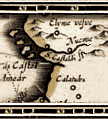







|
|
|
|
Ter'el, the elven god of WisdomBefore the advent of existentialism, the elven people were mostly mystics who worshipped natural deities. The most powerful of those deities was Ter'el, god of the Trees, who later came to embody wisdom. Ter'el was both blind and mute, and could only speak through the wind in the leaves of autumn, who cried tears in the showers of spring, and who passed thunderous judgment in the storms of winter. Early offerings to Ter'el included the best fruit of the harvest, but in time became the small wooden statues known as Li'tani, or Houses-of-the-Soul. Such idols were carved once a year by elven shamans, and were said to hold the true essence of the owner. Once a year the Li'tani were thrown into the fiery altars of Ter'el and burned to ash. By doing so, the elven people thought that Ter'el had purged them of all impurities and pettiness. A new Li'tani was obtained from the elven shaman, and a new cycle could begin again. Geshtianna, human goddess of LoveGehstianna has been a central figure in human Paganism for as long as their history has been recorded. Human mythology claims that Geshtianna was once a mortal woman who was so beautiful that she was made into a god by the moon and the sun, who could no longer bear to be outshone by something so far below them, and so raised her up to the heavens. Humans believed that Geshtianna would smile down upon them at twilight, when the sun was setting and the moon was rising, and that her love and beauty were manifested in the springtime, between winter and the long, hot days of summer. The festivals to the goddess were a time of great celebration, wrought with music and drink, as well as various rites of physicality and fertility. Offerings at the altars of Geshtianna were usually Passion Root, which came to be thought of as an aphrodisiac and was often used during the festivals. |